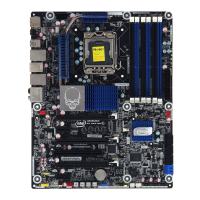Intel Desktop Board DX58SO2 Technical Product Specification
16
Table 3 lists the supported DIMM configurations.
Table 3. Supported Memory Configurations
DIMM
Capacity
Configuration
(Note)
SDRAM
Density
SDRAM Organization
Front-side/Back-side
Number of SDRAM
Devices
512 MB SS 1 Gbit 64 M x16/empty 4
1024 MB SS 1 Gbit 128 M x8/empty 8
1024 MB SS 2 Gbit 128 M x16/empty 4
2048 MB DS 1 Gbit 128 M x8/128 M x8 16
2048 MB SS 2 Gbit 128 M x16/empty 8
4096 MB DS 2 Gbit 256 M x8/256 M x8 16
8192 MB DS 4 Gbit 512 M x8/512 M x8 16
Note: “DS” refers to double-sided memory modules (containing two rows of SDRAM) and “SS” refers to
single-sided memory modules (containing one row of SDRAM).
For information about… Refer to:
Tested Memory http://www.intel.com/support/motherboards/desktop/sb/CS-
025414.htm
XMP Tested Memory http://www.intel.com/personal/gaming/extremememory.htm
1.5.1 Memory Configurations
The Intel Core i7 and Intel Xeon Processors support the following types of memory
organization:
• Tri/Dual channel (Interleaved) mode. This mode offers the highest
throughput for real world applications. Interleaving reduces overall memory
latency by accessing the DIMM memory sequentially. Data is spread amongst the
memory modules in an alternating pattern.
⎯ Three independent memory channels give two possible modes of interleaving:
• Tri-channel mode is enabled when identical matched memory modules are
installed in each of the three memory channels (blue connectors).
• Dual channel mode is enabled when two of the blue memory connectors are
populated with matched DIMMs.
• Single channel (Asymmetric) mode. This mode is equivalent to single channel
bandwidth operation for real world applications. This mode is used when only a
single DIMM is installed or the installed memory modules are not matched.
Technology and device width can vary from one channel to the other.
For information about… Refer to:
Memory Configuration Examples http://www.intel.com/support/motherboards/desktop/sb/cs-
011965.htm

